Charles V. Paterno
Charles Vincent Paterno (born Canio Paternò, August 4, 1878 – May 30, 1946) was an Italian-born American real estate developer. He was called the "Napoleon of the Manhattan Skyscraper Builders".[1]
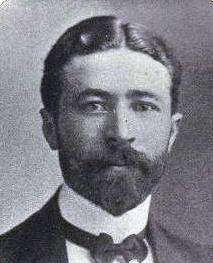
Biography
Born in Castelmezzano, in the Italian region of Basilicata, to Giovanni Paternò, a real estate businessman, and Carolina Trivigno, Paterno relocated to the United States due to financial problems caused by an earthquake which destroyed a construction project that his father was involved with. He graduated from Cornell Medical School in 1899, with the intention of becoming a doctor of medicine but he never practiced the profession, becoming instead a dentist. After his father's death, Paterno and his brother Joseph took over the family real estate business.[2] By 1918 the Paternos owned 75 buildings housing about 28,000 people.[3]
The Paterno name is connected to the construction and the development of a number of modern, luxurious apartment buildings in the Upper East Side, Morningside Heights, and Washington Heights neighborhoods of Manhattan in New York City, including the following residences:
- The Colosseum (1909-1910)
- The Paterno (1909-1910)[4]
- Hudson View Gardens (1923-25)
- 825 Fifth Avenue (1926-1927)
- Castle Village (1938-1939)
Paterno died at the Westchester Country Club in May 30, 1946.[5] He is memorialized by the Paterno Trivium at the intersection of Cabrini Boulevard, West 187th Street, and Pinehurst Avenue in the Hudson Heights subsection of Washington Heights.[6]
Paterno Castle
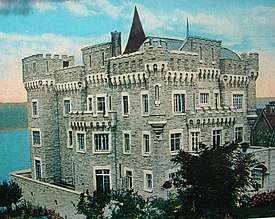
Paterno's seven-acre (2.8 ha) estate, located in what is now the Hudson Heights neighborhood of Manhattan, New York City, featured what was called Paterno's Castle, a Neo-Gothic four-story 35-room mansion built beginning in 1905 and based on a European castle, inspired by a place in Italy that "made a deep impression on him. It was in surroundings similar to the Fort Washington section. When he decided to build himself a home on [Riverside] Drive he remembered this castle and had his home built accordingly.[2] The castle was designed by John C. Watson and built at the cost of over $500,000.[7][8][9] The building's white marble facade featured turrets, and the interior – which was entered through a 75-foot (23 m) underground passageway that went under the building's front – featured a master bedroom which measured 20 feet by 80 feet (6.1m by 25m),[8][3] as well a cellar dedicated to raising mushrooms, called the "mushroom vault". The basement had a swimming pool – which employed filtered water from the nearby Hudson River – which was surrounded by birdcages, as well as massage rooms, Turkish baths, a grill room, and a lounge. The main reception hall was 80-foot (24 m) above street level, off of which were Paterno's den, a parlor, music room and library.[8][2]
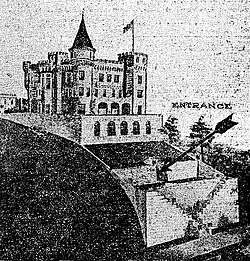
Although the building's facade was medieval, the interior designed was not. Each room was decorated in a different style: Louis XV for the parlor, Colonial for the dining room, Asian for the library. One unique feature of the castle was an antique clock in the entrance hall that, a certain times of the day, operated a $7000 organ located on the second floor gallery, as well as chimes in the castle's tower, which rang on the hour and the half-hour.[2] The organ was expanded a number of times, in 1910, 1911, 1913, and 1927, at the cost of tens of thousands of dollars. When the Castle was slated for demolition, the organ was purchased and donated to St. Paul's Episcopal Church in Glen Cove, New York.[10]
The second floor was the location of the bedrooms – each entered through its own vestibule, as opposed to directly from the hallway – a nursery and a sewing room. The banquet hall and ballroom, each 50 square feet (4.6 m2) with 20-foot (6.1 m) ceilings, along with a billiard room, were on the third floor. The ballroom had balconies with views of the Hudson. Half of the roof was dedicated to a roof garden with a foot and a half of soil. It featured a large conservatory, an aviary, and a solarium.[2]
The grounds featured Italian gardens, greenhouses, colonnades, fountains, and pergolas. At its height, the garage held five Rolls-Royces.[8][2]
Although the mansion was not yet completed, in 1909 Paterno moved in. It was completed in 1916.[2]
After he had moved to Greenwich, Connecticut,[8] the castle and most of the rest of the estate was razed by Paterno in 1938 in order to erect the "Castle Village" complex of co-operative apartments.[11] The area was becoming increasingly residential, and The New York Times quoted Paterno as saying that "the many improvements in that part of the city ... had led to a strong residential movement in that area with a definite demand for the finer type of garden type apartments."[2]

Guest House
The former guest house of the estate is a remnant leftover after the estate's redevelopment. Located at 16 Chittenden Avenue at the corner of West 186th Street, the house was built around 1925, and sits on a 250-foot (76 m) pier suspended over a sheer drop to the Henry Hudson Parkway and the Hudson River Greenway. It was originally commissioned by Cleveland Walcutt, an engineer, who built it on land he purchased from the estate of the editor of the New York Herald, James Gordon Bennett Jr. The house is sometimes referred to locally as "The Pumpkin House", because of its orange color when lit up at night.[12]
The three-story, 3,144-square-foot (292.1 m2), house is configured as a two-family home with separate rental one-bedroom apartment. The main unit includes a parlor floor, a dining room. a library, and a "French country" kitchen. The living room and balcony afford views of the downtown Manhattan skyline, as well as the George Washington Bridge and the Hudson River. On clear days, the new Governor Mario M. Cuomo Bridge (Tappen Zee Bridge) connecting Westchester and Rockland counties can be seen to the north. Upstairs are two master bedrooms, two additional bedrooms which can also be used as studies, and two full bathrooms.
The house was bought in 2000 for $1.1 million. By 2010 the house had only had four owners, and sold c.2011 for around $3.9 million. In 2016, it was put on the market at the asking price of $5.25 million, and after almost three years, it was sold in January 2019 for $2 million.[13][14]
Several other remnants of the estate are still extant, but are part of the Castle Village complex.
Retaining wall
One remnant of the Paterno estate is the 75-foot retaining wall, originally built to protect Riverside Drive which now protects the Henry Hudson Parkway. On May 12, 2005, the wall collapsed, resulting a massive landslide which buried the northbound lanes of the parkway and six parked cars. The collapse stopped traffic on the highway for several days, but the clean-up began quickly, and the road re-opened on May 15.[15] However, an entry ramp to the highway remained closed for almost two years. No one was injured. A later study found that the collapse could have been prevented.[16]
Reconstruction of the wall, which had been built in 1925, was substantially completed by October 2007, at the cost of $24 million. The access ramp to the Henry Hudson Parkway below the wall was partially reopened in March 2008. All reconstruction on the wall, including the full opening of the access ramp was complete by November 2010.[17]
Gallery
_cropped.jpg) The Colosseum apartment building in 1910
The Colosseum apartment building in 1910 The Paterno in 1910
The Paterno in 1910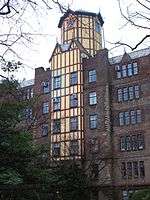 Hudson View Gardens as seen from Bennett Park
Hudson View Gardens as seen from Bennett Park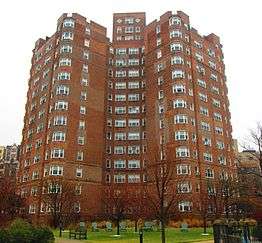 A building of the Castle Village complex
A building of the Castle Village complex 825 Fifth Avenue, c.1939-1941
825 Fifth Avenue, c.1939-1941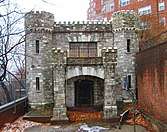 A remnant of the Paterno estate, now a utility building for Castle Village
A remnant of the Paterno estate, now a utility building for Castle Village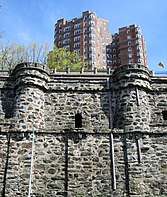 The retaining wall from the estate is still used for Castle Village, seen behind it.
The retaining wall from the estate is still used for Castle Village, seen behind it.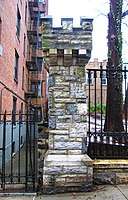 A stone pillar remnant from the estate
A stone pillar remnant from the estate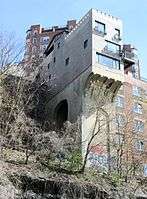 The "Pumpkin House", the former guest house of the Paterno estate as seen from the Hudson River Greenway.
The "Pumpkin House", the former guest house of the Paterno estate as seen from the Hudson River Greenway.
References
Notes
- Italian Americana, Volume 8, 1986, p.10
- Miller, Tom (July 16, 2012) "The Lost 1909 Paterno Castle -- 185th Street and Riverside Drive" Daytonian in Manhattan
- Walsh, Kevin (December 22, 2000) "Postcards from the Edge of Town" Forgotten NY
- Gray, Christopher (August 15, 1999). "The Colosseum and the Paterno, 116th Street and Riverside Drive; At Curves in the Road, 2 Unusually Shaped Buildings". The New York Times. Retrieved 2008-02-07.
- Staff (May 31, 1946). "Charles V. Paterno (obituary)". The Brooklyn Daily Eagle. p. 11. Retrieved January 9, 2016.
- Paterno Trivium, New York City Parks and Recreation Department
- Oteri, Danielle (November 15, 2013) "A Neighborhood of Castles in the Sky: Washington Heights before The Cloisters" Metropolitan Museum of Art
- Staff (January 22, 2010) "Patrno's Castle" My Inwood
- Hogarty, Dave (May 15, 2012) "Cornerspotted: Paterno Castle of Washington Heights" Curbed
- Staff (ndg) "Dr. Charles V. Paterno Residence" New York City Chapter of the American Guild of Organists website
- "Demolishing A Castle In New York 1938" (video) British Pathé
- White, Norval; Willensky, Elliot & Leadon, Fran (2010). AIA Guide to New York City (5th ed.). New York: Oxford University Press. p. 571. ISBN 978-0-19538-386-7.
- Carlson, Jen (August 15, 2016) "NYC's Incredible Cliffside 'Pumpkin House' Is For Sale" Archived 2018-10-06 at the Wayback Machine Gothamist
- Keil, Jennifer Gould (January 17, 2019) "Someone finally bought NYC’s iconic ‘Pumpkin House’" New York Post
- "Board of Inquiry Report – Castle Village Retaining Wall Collapse" (PDF). New York City Department of Buildings. April 2007. Archived from the original (PDF) on May 24, 2011. Retrieved April 2, 2010.
- "Report: Retaining wall collapse along Henry Hudson Parkway could have been prevented". Staten Island Advance. Associated Press. 11 May 2007. Retrieved 30 April 2014.
- Teal, Brett (23 November 2010). "Castle Village residents' 5-year reconstruction ordeal finally ends". Northattan. Archived from the original on 2 May 2014. Retrieved 30 April 2014.
Further reading
- "Charles V. Paterno: His Castle Ruled Washington Heights" Keith York City
External links


